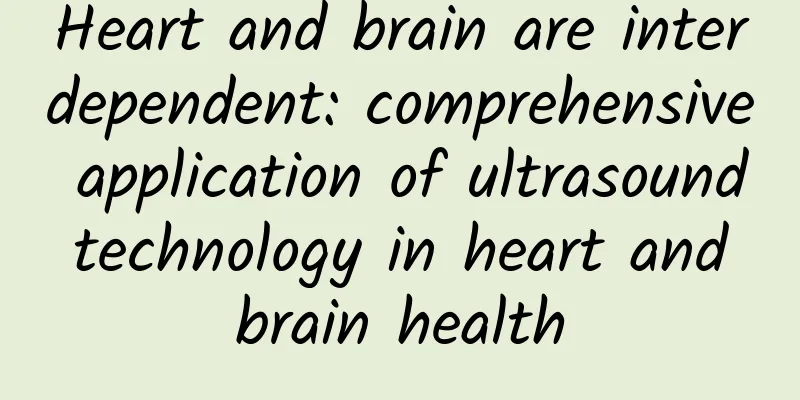Heart and brain are interdependent: comprehensive application of ultrasound technology in heart and brain health

|
Author: Zhang Lei, deputy chief physician, Xuanwu Hospital, Capital Medical University Reviewer: Xia Jinggang, Chief Physician, Xuanwu Hospital, Capital Medical University The healthy connection between the heart and the brain is not only reflected in the physiological level, but also has a profound impact on the prevention, diagnosis and treatment of diseases. With the continuous advancement of medical technology, especially the widespread application of ultrasound technology, we have a clearer understanding of the importance of treating the heart and brain together. The following will elaborate on the connection between heart and brain health, common risk factors, the specific application of ultrasound technology, and look forward to the future development trend of medicine in this field. Figure 1 Copyright image, no permission to reprint 1. The Intrinsic Connection between Heart and Brain Health 1. Interdependence of physiological mechanisms The close connection between the heart and the brain is not just a simple supply-demand relationship, but a complex physiological network. The heart pumps oxygen- and nutrient-rich blood throughout the body, including the brain, through continuous beating. The brain uses these resources to perform a variety of complex cognitive and emotional functions, and finely regulates heart function through neural and hormonal regulatory mechanisms. This interdependent relationship ensures the stable operation of the heart-brain system. 2. Interactions between disease states This interaction becomes more significant when there is a disease in the heart or brain. For example, patients with heart disease suffer from insufficient blood supply to the brain due to a weakened heart pumping function, which in turn leads to serious consequences such as stroke and cognitive impairment. Similarly, brain diseases such as depression and anxiety can also affect heart health through neuro-endocrine pathways and increase the risk of heart disease. Therefore, when treating heart and brain diseases, it is necessary to fully consider the interaction between the two and adopt comprehensive treatment measures. 2. Common risk factors for heart and brain diseases 1. Hypertension As the number one risk factor for cardiovascular and cerebrovascular diseases, the harm of hypertension cannot be underestimated. Long-term hypertension can lead to hardening of the blood vessel walls and decreased elasticity, which in turn can cause atherosclerosis and thrombosis. This will not only increase the risk of coronary heart disease and stroke, but also cause lasting damage to the cardiovascular and cerebrovascular systems. Therefore, controlling blood pressure is the key to preventing and treating cardiovascular and cerebrovascular diseases. 2. Diabetes Due to insufficient insulin secretion or dysfunction, diabetic patients have continuously elevated blood sugar levels. Hyperglycemia can damage vascular endothelial cells and promote the occurrence and development of atherosclerosis. In addition, diabetic patients are often accompanied by risk factors such as hyperlipidemia and hypertension, which further increases the risk of cardiovascular and cerebrovascular diseases. Therefore, for diabetic patients, in addition to controlling blood sugar levels, they also need to pay attention to changes in indicators such as blood lipids and blood pressure. 3. Hyperlipidemia High cholesterol levels are one of the important risk factors for atherosclerosis. In particular, elevated levels of low-density lipoproteins accelerate lipid deposition and inflammatory responses under the arterial intima, forming atherosclerotic plaques. Once these plaques rupture or fall off, they will form blood clots and block blood vessels, leading to serious consequences such as heart disease and stroke. Therefore, reasonable control of blood lipid levels is of great significance for preventing heart and brain diseases. 4. Smoking and drinking Smoking and excessive drinking are two unhealthy lifestyles that cause cardiovascular and cerebrovascular diseases. Smoking damages vascular endothelial cells and promotes the occurrence of arteriosclerosis, while excessive drinking can lead to serious consequences such as high blood pressure, arrhythmias, and myocardial damage. In addition, smoking and drinking increase the risk of mental problems such as anxiety and depression, further exacerbating the deterioration of cardiovascular and cerebrovascular health. Therefore, quitting smoking and limiting alcohol consumption are important measures to prevent cardiovascular and cerebrovascular diseases. III. The role of ultrasound technology in treating both heart and brain 1. Cardiac Ultrasound As a non-invasive and convenient imaging examination method, cardiac ultrasound plays an important role in the diagnosis of heart disease. The characteristics of ultrasound can clearly show the structure and functional status of the heart. Doctors can observe information such as the size of the heart chamber, the thickness of the myocardium, the morphology and function of the heart valves, and the hemodynamic changes of the heart. This information is of great value for the diagnosis, condition assessment and formulation of treatment plans for heart disease. 2. Real-time monitoring of cranial ultrasound Cranial ultrasound, especially transcranial Doppler ultrasound (TCD), can monitor the blood flow velocity and hemodynamic changes of cerebral blood vessels in real time. TCD examination can evaluate the degree of stenosis of cerebral blood vessels, blood flow resistance and the establishment of collateral circulation. This information is of great significance for the early diagnosis of stroke, disease assessment and monitoring of treatment effects. In addition, TCD can also be used for the diagnosis of diseases such as cerebral vasospasm and cerebral arteriovenous malformations. 3. Carotid artery ultrasound Carotid ultrasound is one of the important tools for evaluating carotid atherosclerosis and atherosclerotic plaque formation. Carotid ultrasound examination can clearly show the wall structure of the carotid artery, the size and shape of plaques, and blood flow velocity. This information is of great value in predicting the risk of stroke and formulating personalized prevention and treatment plans. Especially for people with risk factors such as hypertension and diabetes, regular carotid ultrasound examinations can promptly detect early signs of carotid stenosis and take appropriate intervention measures to prevent the occurrence of stroke. 4. Joint diagnosis of heart and brain diseases In actual clinical applications, ultrasound technologies such as cardiac ultrasound, cranial ultrasound and carotid ultrasound are often not used in isolation, but are combined and used in an integrated manner. Doctors can choose appropriate ultrasound examination methods for combined examinations based on the patient's specific conditions to obtain more comprehensive and accurate heart and brain health assessment results. For example, for patients suspected of coronary heart disease, doctors can first perform a cardiac ultrasound to assess the structural and functional status of the heart, then perform a carotid ultrasound to assess carotid artery sclerosis and plaque formation, and finally perform a cranial ultrasound to assess the health of cerebrovascular vessels. Such a comprehensive examination can provide a more comprehensive understanding of the patient's heart and brain health status and provide strong support for subsequent treatment. Figure 2 Copyright image, no permission to reprint IV. Comprehensive management strategy for treating both the heart and the brain In addition to using ultrasound technology for diagnosis and monitoring, the treatment of heart and brain diseases also requires comprehensive management strategies. These strategies include regular physical examinations, maintenance of a healthy lifestyle, psychological stress management, and drug treatment. Through comprehensive management, the incidence of heart and brain diseases can be effectively reduced and the quality of life of patients can be improved. 1. Regular physical examinations and ultrasound examinations Regular physical examinations and ultrasound examinations are particularly important for high-risk groups, such as those with hypertension, diabetes, heart disease, or a family history of stroke. Cardiac ultrasound, carotid ultrasound, and TCD examinations can help doctors detect the risk of cardiovascular and cerebrovascular diseases early and provide data support for personalized treatment plans. Through these examinations, doctors can monitor changes in cardiovascular and cerebrovascular systems, adjust treatment strategies in a timely manner, and prevent the progression of the disease. 2. Maintenance of a healthy lifestyle Maintaining a healthy lifestyle is also crucial to preventing heart and brain diseases. First, a balanced diet is the basis for maintaining heart and brain health. A low-salt, low-fat, high-fiber diet helps control blood pressure and cholesterol levels and reduce the risk of arteriosclerosis. Secondly, regular physical exercise can enhance the function of the heart and blood vessels, improve blood circulation, and thus reduce the incidence of heart and brain diseases. At least 150 minutes of moderate-intensity aerobic exercise per week, such as brisk walking and swimming, can help maintain heart and brain health. 3. Psychological stress management Mental health has an important impact on the prevention and treatment of cardiovascular and brain diseases. Long-term stress not only affects the cognitive function of the brain, but also increases the incidence of heart disease. Through meditation, yoga, deep breathing and other relaxation techniques, stress can be effectively relieved and the risk of cardiovascular and brain diseases can be reduced. Social support is also a key factor in mental health management. Maintaining good interpersonal relationships and active social activities can help reduce psychological stress and thus improve overall health. 4. Medication Drug therapy is an important part of managing cardiovascular and cerebrovascular diseases. Drug management is essential for patients who already have hypertension, diabetes, or high cholesterol. Under the guidance of a doctor, patients need to take antihypertensive drugs, hypoglycemic drugs, and lipid-lowering drugs to maintain normal blood pressure, blood sugar, and blood lipid levels. In addition, for patients at risk of arrhythmia or thrombosis, the use of anticoagulants can effectively prevent cardiogenic stroke. Drug therapy should be combined with lifestyle adjustments to form a long-term comprehensive treatment strategy. 5. Future Prospects of Treating the Heart and Brain Together With the advancement of medical technology, the concept and practice of treating both the heart and brain are constantly developing. The application of ultrasound technology plays an irreplaceable role in the management of heart and brain diseases. The development of ultrasound equipment and technology in the future will further improve its diagnostic accuracy and breadth of application. In addition, based on the development of artificial intelligence and big data technology, the analysis of ultrasound imaging data will become more precise, helping doctors make faster and more accurate diagnostic decisions. |
<<: Talk about leg cramps during pregnancy
Recommend
What can pregnant women eat to feel better after vomiting?
Morning sickness is basically a pregnancy reactio...
What causes red blood streaks on cheeks?
Fair and rosy skin is what girls have always been...
How to deal with spotting during pregnancy
We all know that men and women are not allowed to...
Why do women get candida infection?
If there is a case of Trichomonas infection, whic...
What are the signs one hour before a dog gives birth? If a dog starts scratching the ground, is it time to give birth?
The reproduction method of dogs is no different f...
Will ovarian removal cause aging?
Some female friends have one ovary that is diseas...
Leucorrhea is particularly heavy and looks like water
Girls will have vaginal discharge when they reach...
Can listening to music improve sleep? Come! Let's listen to hypnotic songs, but be careful of "earworms"
We spend one third of our lives sleep Good qualit...
What to do about antibody infertility
In fact, many women will have immune infertility,...
What does Qing Palace mean?
Nowadays, many women think that if they don't...
What are the symptoms of spleen and kidney yang deficiency in women?
Due to the increasing intensity of work and press...
What to do if you have vaginal candidal infection in late pregnancy
Candidal vaginitis is a common gynecological dise...
Female organ pictures
The female urinary system includes the internal a...
Can regular infusion prevent cerebral infarction? Don't believe it, it's very dangerous!
Rumor: "Regular infusion can prevent cerebra...
How do uterine polyps form?
In life, many women suffer from uterine polyps. I...









